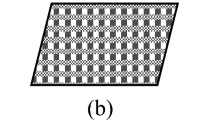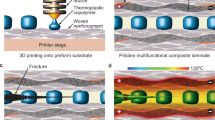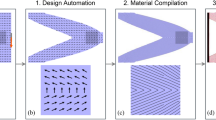Abstract
Traditional fibre-reinforced composite materials with excellent in-plane properties fare poorly when out-of-plane through-thickness properties are important1. Composite architectures with fibres designed orthogonal to the two-dimensional (2D) layout in traditional composites could alleviate this weakness in the transverse direction, but all of the efforts1,2 so far have only produced limited success. Here, we unveil an approach to the 3D composite challenge, without altering the 2D stack design, on the basis of the concept of interlaminar carbon-nanotube3,4 forests that would provide enhanced multifunctional properties along the thickness direction. The carbon-nanotube forests allow the fastening of adjacent plies in the 3D composite. We grow multiwalled carbon nanotubes on the surface of micro-fibre fabric cloth layouts, normal to the fibre lengths, resulting in a 3D effect between plies under loading. These nanotube-coated fabric cloths serve as building blocks for the multilayered 3D composites, with the nanotube forests providing much-needed interlaminar strength and toughness under various loading conditions. For the fabricated 3D composites with nanotube forests, we demonstrate remarkable improvements in the interlaminar fracture toughness, hardness, delamination resistance, in-plane mechanical properties, damping, thermoelastic behaviour, and thermal and electrical conductivities making these structures truly multifunctional.
This is a preview of subscription content, access via your institution
Access options
Subscribe to this journal
Receive 12 print issues and online access
$259.00 per year
only $21.58 per issue
Buy this article
- Purchase on Springer Link
- Instant access to full article PDF
Prices may be subject to local taxes which are calculated during checkout




Similar content being viewed by others
References
Tong, L., Mouritz, A. P. & Bannister, M. 3D Fibre Reinforced Polymer Composites (Elsevier Science, Oxford, 2002).
Dow, M. B. & Dexter, H. B. Development of stitched, braided and woven composite structures in the ACT program and at Langley Research Center. NASA Technical Report<http://techreports.larc.nasa.gov/ltrs/PDF/1997/tp/NASA-97-tp206234.pdf> 1–5 (1997).
Dresselhaus, M. S., Dresselhaus, G. & Eklund, P. C. Science of Fullerenes and Carbon Nanotubes (Academic, San Diego, 1996).
Baughman, R. H., Zakhidov, A. A. & de Heer, W. A. Carbon nanotubes-the route toward applications. Science 297, 787–792 (2002).
Mouritz, A. P. Fracture and tensile fatigue properties of stitched fibreglass composites. J. Mater. Des. Appl. 218, 87–93 (2004).
Dexter, H. B. & Funk, J. G. in 27th AIAA Structural Dynamics and Materials Conference (San Antonio, TX) AIAA Paper 86-1020 700–709 (American Institute of Aeronautics and Astronautics, New York, 1986).
Tai, N. H., Yeh, M. K. & Liu, J. H. Enhancement of the mechanical properties of carbon nanotube/phenolic composites using a carbon nanotube network as the reinforcement. Carbon 42, 774–777 (2004).
Thostenson, E. T., Li, C. & Chou, T. W. Nanocomposites in context. Compos. Sci. Technol. 65, 491–516 (2005).
Ruoff, R. S. & Lorents, D. C. Mechanical and thermal properties of carbon nanotubes. Carbon 33, 925–930 (1995).
Yu, M. F. et al. Strength and breaking mechanism of multiwalled carbon nanotubes under tensile load. Science 287, 637–640 (2000).
Calvert, P. Nanotube composites: a recipe for strength. Nature 399, 210–211 (1999).
Andrews, R. et al. Continuous production of aligned carbon nanotubes: a step closer to commercial realization. Chem. Phys. Lett. 303, 467–474 (1999).
Mazumdar, S. K. Composites Manufacturing: Materials, Product, and Process Engineering (CRC Press, Boca Raton, 2002).
Cao, A. et al. Multifunctional brushes made from carbon nanotubes. Nature Mater. 4, 540–545 (2005).
Ghasemi-Nejhad, M. N., Chandramouli, M. V. & Yousefpour, A. Processing and performance of continuous fiber ceramic composites by preceramic polymer pyrolysis: I—filament winding. J. Compos. Mater. 35, 2207–2237 (2001).
Ghasemi-Nejhad, M. N., Bayliss, J. K. & Yousefpour, A. Processing and performance of continuous fiber ceramic composites by preceramic polymer pyrolysis: II—resin transfer molding. J. Compos. Mater. 35, 2239–2255 (2001).
Adams, D. F., Carlsson, L. A. & Pipes, R. B. Experimental Characterization of Advanced Composite Materials 3rd edn (CRC Press, Boca Raton, 2003).
Martin, R. H. in Proc. Am. Soc. Compos. Third Technical Conference (Seattle, Washington) 688–701 (Technomic, Lancaster, Pennsylvania, 1988).
Prel, Y. J., Davies, P., Benzeggagh, M. L. & de Charentenay, F. Composite Materials: Fatigue and Fracture, Proc. 2nd. Symp. (Cincinnati, Ohio) Vol. 2, 251–269 (American Society for Testing and Materials, Philadelphia, Pennsylvania, 1989).
Koratkar, N., Wei, B. & Ajayan, P. M. Carbon nanotube films for damping applications. Adv. Mater. 14, 997–1000 (2002).
Zhang, M., Atkinson, K. R. & Baughman, R. H. Multifunctional carbon nanotube yarns by downsizing an ancient technology. Science 306, 1358–1361 (2004).
Zhou, X., Shin, E., Wang, K. W. & Bakis, C. E. Interfacial damping characteristics of carbon nanotube-based composites. Compos. Sci. Technol. 64, 2425–2437 (2004).
Kwon, Y-K., Berber, S. & Tománek, D. Thermal contraction of carbon fullerenes and nanotubes. Phys. Rev. Lett. 92, 015901 (2004).
Acknowledgements
We thank B. Crawford of MTS Nano Instruments, for many helpful discussions. V.P.V. and M.N.G.-N. acknowledge the support of the ADPICAS project funded by the Office of Naval Research under government grant numbers N00014-00-1-0692 and N00014-05-1-0586. A.C. acknowledges the ADPICAS project as well as the start-up support from the College of Engineering and the Department of Mechanical Engineering at the University of Hawaii at Manoa. P.M.A. acknowledges the support of the Focus Center of New York for Electronic Interconnects and the NSF Nanoscale Science and Engineering Center for the directed assembly of nanostructures.
Author information
Authors and Affiliations
Corresponding authors
Ethics declarations
Competing interests
The authors declare no competing financial interests.
Supplementary information
Supplementary Information
Supplementary information, equations S1-S2 and figures S1-S4 (PDF 442 kb)
Rights and permissions
About this article
Cite this article
Veedu, V., Cao, A., Li, X. et al. Multifunctional composites using reinforced laminae with carbon-nanotube forests. Nature Mater 5, 457–462 (2006). https://doi.org/10.1038/nmat1650
Received:
Accepted:
Published:
Issue Date:
DOI: https://doi.org/10.1038/nmat1650
This article is cited by
-
Influence of purity and level of disorder on the spinnability of CNTs yarn derived from the CNTs forest grown by a parametrically tuned CVD
Journal of Materials Science (2024)
-
Morphology-property relationship in radially oriented anchored carbon nanotubes on polybenzimidazole nanofibers
Journal of Materials Science (2023)
-
A Review on Fracture Analysis of CNT/Graphene Reinforced Composites for Structural Applications
Archives of Computational Methods in Engineering (2022)
-
A graphene film interlayer for enhanced electrical conductivity in a carbon-fibre/PEEK composite
Functional Composite Materials (2021)
-
Mechanically excellent nacre-inspired protective steel-concrete composite against hypervelocity impacts
Scientific Reports (2021)



